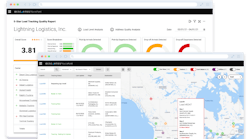So-called push-to-talk (PTT) services – also known as “press-to-transmit” in some corners – is a method of speaking via what are dubbed “half-duplex” communication lines, including two-way radios, using a momentary button to switch from voice reception to transmit mode.
Long a critical tool for field service workers, PTT technology is now being upgraded by several carriers in part to help “bridge the gap” between two-way radios and mobile Internet communication pathways.
AT&T recently introduced what it calls enhanced PTT or “EPTT” and integrated dispatch offerings to give dispatchers and field workers more “flexibility” in terms of how they communicate with one another, said Abhi Ingle, senior VP-big data and advanced solutions for AT&T Mobile and Business Solutions, in a statement.
“Businesses want the speed, coverage and reliability that mobile Internet services offer for two-way communication,” Ingle added. “We are making the transition easier for companies by offering a solution that replicates the two-way radio experience on mobile devices and communicates with older systems so our customers’ employees are always connected.”
Some of the technology being deployed to provide such PTT flexibility includes:
- Talk Group Scanning: A feature lets a manager prioritize and preset talk groups on their AT&T EPTT mobile device. Supervisors can quickly find the right conversation when monitoring multiple events or activities at the same time.
- Broadcast Calling: Immediate announcements to a large team are the key benefit to this option. Users can broadcast a call to up to 500 AT&T EPTT subscribers.
- Sonim XP Channel Select Module: Created for the Sonim XP6, the Channel Select Module is as easy to use as switching channels on a radio. Users can turn a knob on the smartphone to quickly switch talk groups.
- Application Programming Interfaces (API) integration: This allows field service software providers can incorporate real-time push-to-talk communication into their dispatch systems through AT&T EPTT APIs.
- Secure Communication: AT&T said its EPTT meets the requirements of Federal Information Processing Standard (FIPS) publication 140-2. FIPS is a U.S government computer security standard used to test and validate product security.
On another front, Pacific DataVision (PDV) – which bought Sprint’s nationwide 900 megahertz (MHz) spectrum for $100 million last September – is ramping up its focus on the two-way radio market, with plans to deploy its new PTT dispatch network in major U.S. metropolitan locations this year.
The company said will focus those networks on the needs of dispatch-centric businesses such as transportation, distribution, construction, hospitality, and waste management.
“The past nine months have been a remarkable period for us,” noted John Pescatore, PDV’s CEO, in the company’s earnings report last month.
“We expect to have service available in our first four markets by the end of June,” he added. “Overall, this should be an exciting year for us as we continue deploying our next generation two-way services in additional markets.”
Pescatore also said that PDV filed a petition with the Federal Communications Commission (FCC) requesting re-alignment of its 900 MHZ band to create a spectrum “capable of serving the broadband needs of utilities, energy companies, transportation providers and others” as well as ensuring priority access for utilities and other critical infrastructure companies.



